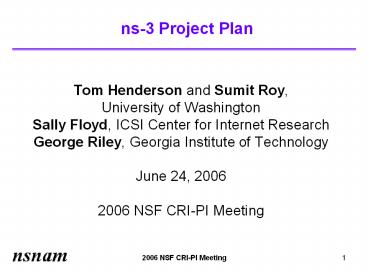ns-3 Project Plan - PowerPoint PPT Presentation
Title:
ns-3 Project Plan
Description:
protocol design, large scale systems studies, prototyping, education ... applications (e.g., BitTorrent), other models of important research/educational interest ... – PowerPoint PPT presentation
Number of Views:412
Avg rating:3.0/5.0
Title: ns-3 Project Plan
1
ns-3 Project Plan
- Tom Henderson and Sumit Roy,
- University of Washington
- Sally Floyd, ICSI Center for Internet Research
- George Riley, Georgia Institute of Technology
- June 24, 2006
- 2006 NSF CRI-PI Meeting
2
What is ns?
- ns is a discrete-event network simulator for
Internet systems - protocol design, large scale systems studies,
prototyping, education - ns has a companion network animator called nam
- hence, has been called the nsnam project
3
What is ns (cont)?
- INSERT nam animation movie here
4
ns-2 Impact
- ns is a research community resource
- Other statistics
- Over 50 of ACM and IEEE network simulation
papers from 2000-2004 cite the use of ns-2 - Source ACM Digital Library and IEEExplore
searches - 8000 downloads/month, 450 messages/month on
ns-users mailing list - November 2005-May 2006
Source Search of ACM Digital Library papers
citing simulation, 2001-04
5
ns-2 Funding History
- Funding on the simulator itself finished in 2000
- Current software is out-of-date
- models, GUI, overall software design, scripting
interface
6
Technical Goals of the ns-3 Project
- Develop a redesigned network simulation tool for
Internet research and education - Core Redesign the core of the simulator
- Integration Better software encapsulation and
integration - Models Updated protocol models
- Education New educational support
- Maintenance Testing, documentation, support
7
ns-3 Program Details
- Four-year, multi-institution collaboration
- External collaborations also desired
- INRIA Sophia-Antipolis, Planete research group
- Industry (TBD)
- Existing ns-2 user/research community
- CRI funding supports 1 staff programmers, 1
students, PIs - Software developed using freely available tools
on commodity hardware - Open source licensing and development model
8
Core Refactor the ns core
- Current limitations
- Scalability, scripting interface, emulation
support - Design themes
- Features C core, new scripting interface
(TBD), improved emulation support, new animation - Techniques modern object-oriented design
patterns, support for parallel execution and
staged computations, better tracing and
statistics computation, - Leveraging
- Georgia Tech Network Simulator (GTNetS)
- yans (INRIA)
- Parallel, Distributed ns (PDNS)
- staging techniques such as SNS (Cornell)
- others
9
Integration Reuse more code
- Current limitations
- protocol implementations need to be specially
written for simulation environment or abstraction
library - trace files and simulation outputs are
non-standard formats - Design themes
- APIs and software support for process-driven
implementations in an event-driven simulation
framework - standard (e.g., pcap) simulation outputs
- Leveraging
- Network Simulation Cradle (Jansen)-- methodology
for porting kernel code into ns-2 - New techniques for linking existing application
code - Experience with porting quagga routing to ns-2
and GTNetS
10
Integration Interact with real-world
- Current limitations
- emulation code is out-of-date
- difficult to transition between simulations and
PlanetLab (or real) experiments - Design themes
- revised emulation support
- interfaces for PlanetLab
- continued support of Utahs Emulab and other
testbeds - Leveraging
- University of Magdeburg (Mahrenholz) third-party
emulation extensions - planned collaboration with PlanetLab and Emulab
projects
11
Models Update available models
- Current limitations
- little support for peer-to-peer applications,
IEEE 802.11 variants, IPv6 protocols, modern
routing protocols, new network architectures
(e.g., DTN) - Design themes
- Emphasis on wireless, new traffic models,
emerging protocols (e.g., high-speed TCP) and
applications (e.g., BitTorrent), other models of
important research/educational interest - Leveraging
- Software from other open-source projects
- Contributed ns-2 code where possible
Community contribution of models has been
outstanding for ns-2
12
Models Update available models (cont.)
13
Education More impact in courses
- Current limitations
- students find current scripting syntax arcane
- protocol models are sometimes too abstracted
- paucity of educational scripts
- Design themes
- more implementation-oriented architecture and
software - revised user interface
- integration with courseware and texts,
- Leveraging
- efforts to integrate more real-world code (above)
- simulation framework that better mirrors
implementations - use in PIs courses
14
Maintenance
- Funding for staff programmers to
- Maintain ns-2 while we transition
- Implement the selected architecture
- Reuse and clean up existing ns-2 and GTNetS
models - Model validation and debugging
- Documentation
- Regression testing
- Software packaging and releases
- Educational script generation
15
Broader impacts
- CRI funding intended to seed the larger nsnam
project - Well continue to solicit inputs and
participation from the broader networking
community - Project will use established open source
development practices - ns-3 will use a free software licensing structure
encouraging academic and commercial participation - Our intent is to make the simulator a
self-sustaining project driven by research
community inputs and industry funding
Leverage and grow the network effect of ns-2s
user base
16
Criteria for success
- In four years, ns-3 will be a success if it
- continues to be preferred simulation environment
for network research - performance, scalability, openness
- comprehensive and current model support
- allows easy integration of implementation code
- allows researchers to more easily move between
simulation and live experiments - contains current wireless and application models
- is used for undergraduate/graduate courseware
- project is self-sustaining beyond CRI funding
17
Questions?
- Web site
- http//www.nsnam.org
- Mailing list
- http//mailman.isi.edu/mailman/listinfo/ns-develop
ers































